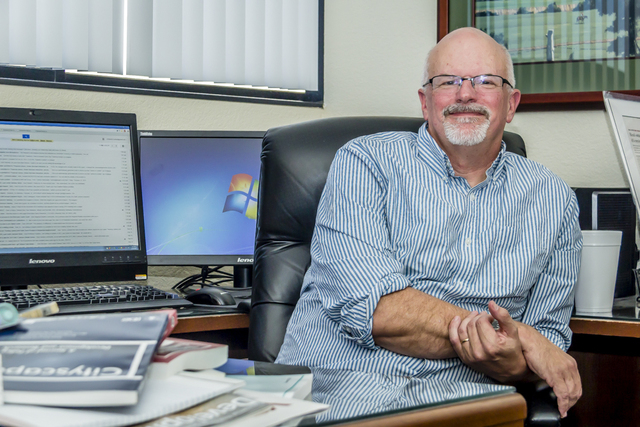


It’s the question everybody keeps asking since Las Vegas started its recovery from the Great Recession.
Is the Southern Nevada commercial real estate market back yet?
There’s no one-word answer to that question because it depends on the commercial sector and even where it’s located in the valley.
“The answer to the question of are we back yet is ‘sort of,’ ” said Edward Coulson, professor of economics and director of the Lied Institute for Real Estate Studies at UNLV. “Everybody seems positive about the industry, but there are still definitely some weak spots.”
When Coulson talks about weak spots, he’s referring to the office market that was overbuilt during the boom and has yet to absorb the empty space. Retail space is faring better than office, but it has yet to bounce back to where it was before the Great Recession.
The answer is yes, however, when it comes to the industrial market, which Coulson said is doing “pretty well” by comparison. Vacancy rates keep dropping to the point where there’s a shortage of industrial space, he said.
“It strikes me that the industrial sector is as good as or better than it was before the boom,” Coulson said. “It seems really strong and things are looking really quite optimistic. People are very optimistic.”
Industrial ‘robust’
Mike Shohet, president of NAIOP, the president of the Southern Nevada Chapter of the Commercial Real Estate Development Association, agrees that industrial is back and very healthy with robust absorption.
But to answer the question of whether Las Vegas commercial real estate is back, Shohet agrees there are multiple answers, depending on the product type.
“I would say retail is right at the front end of the recovery, and there’s still a lot of runway ahead,” Shohet said. “Office has been the laggard. It was the most overbuilt during the recession and the slowest to recover. But the brokerage community is feeling more optimistic. During the recession, all the activity was just players moving around in the market, finding better space. Net absorption was decidedly negative at the beginning of the recession and in the first years of the recovery net absorption was flat with all of the new activity being relocations. Now you’re starting to see new players coming into the market. “
What’s getting the most attention, meanwhile, is the industrial sector because of the limited land available for development and limited space throughout the market even prior to the recession. The plans of Faraday Future opening an assembly line for electric cars in 3 million square feet at the North Las Vegas Apex Industrial Park by end of 2017 has drawn national attention to Southern Nevada.
“This is the healthiest the industrial real estate market has been since the recession,” Shohet said. “If you look at absorption, it’s as high as it’s been since the recession.”
Small spaces remain
John Restrepo, principal with RCG Economics, said it’s gotten to the point that most of the industrial space available is up to 25,000 square feet and the shortage is in space larger than that.
The economy is returning and the economic growth has increased the demand for industrial space again. That’s moving vacancy rates closer to the 3 percent range it was during the boom, Restrepo said. During the recession some industrial land got repositioned for future home building, he said.
“We have a shortage now because we haven’t been able to build enough industrial space to accommodate a growing economy,” Restrepo said. “It’s pretty healthy right now but there’s a problem with a lack of space and that could slow down our economic growth. A healthy economy needs a healthy amount of industrial space to support it.”
A lack of space means losing out to competitors in the Inland Empire of Southern California and Phoenix, Restrepo said. The lack of land, space and high prices have hurt the region for 20 years, he said.
Avoiding excess
Las Vegas has had a tendency to overbuild space like it did in the office market prior to the recession, but neither Restrepo, Coulson nor Shohet expect that to happen in the industrial sector with the economy recovering and demand high. Shohet said most of the brokers and developers in the market have the same opinion.
“The amount of development is not over the top and reasonable based on the level of demand,” Shohet said. “Buildings are getting leased up as they’re being built or right after. There’s a couple of new buildings in the market that haven’t been leased up yet but that’s not due to a lack of demand but landlords are waiting for the right user and tenant. It seems like supply and demand are in alignment right now.”
Shohet said he’s concerned about land prices creeping up, which is not good for industrial developers in the southwest valley with freeway frontage. Rents are recovering but they’re not quite there yet.
“Land in the southwest along well-located freeway frontage is in the high teens,” Shohet said. “That doesn’t work for industrial development. Land prices are getting up to where they used to be, and that’s not a good thing.”
The industrial and office markets couldn’t be further apart in how they’ve recovered since the recession.
Office woes continue
Vacancy rates for office space were as high as 25 percent in 2013 and now are down to about 20 percent, Coulson said. Rents are up since then but the overhang of construction during the boom will remain until the economy gets a further boost, he said.
“It’s going to take a lot of growth that seems to be on the horizon,” Coulson said. “The labor market indicators are pretty good. The unemployment rate is converging on the national unemployment rate. Wages are slightly higher than they were before. The labor market signs are there. There are all these initiatives that are coming down the pike in the next three or four years that will continue to strengthen and diversify the economy of the region.”
That could happen with the development of a UNLV medical school, the Faraday Future plant expected to add several thousand jobs and resort development along the north end of the Strip, Coulson said.
“There will be growth in population and there will be growth in jobs and that will have an impact on the office market and the retail market,” Coulson said. “That will help fill space, but I don’t know if there will be a lot more construction of office space in the near future just because we’re still dealing with that overhang. Maybe that’s going to fill out before there can be a fast pace with office construction. That’s going to take awhile. With a 20 percent vacancy rate, that’s going to be hard to justify except in certain niche spaces.”
Niche products
Some of those niche spaces are call centers and some developers are looking at build-to-suit space or speculative development, Shohet said. Land prices in the southwest valley are making that difficult, however, because call centers require specific building types and a lot of parking space because they have a lot of workers, he said.
“The amount of vacant space in the market that meets that criteria is pretty low,” Shohet said. “It will take awhile for office to recover. There is some product out there that is functionally obsolete that will never be back.”
Restrepo said many businesses moved into lower quality space during the recession so they could spend money on other needs such as paying employee salaries over rent. Many small businesses “are still finding the way out of the recession and remain cost-conscious about taking on more expensive space,” he said.
“People are being very careful on how much they’re spending for rent. It’s getting better but they are still watching,” said Restrepo, who added that there is about seven to eight years of office supply left.
Retail ‘stable’
The segment caught in the middle between office and industrial is retail. Coulson called it stable but at a higher vacancy rate than people would like at around 11 percent. That market tends to follow rooftops, and there has been a softness throughout the country because people are doing more shopping online.
“As the economy grows and we fill in the space that is currently available, you’re going to see some growth in the retail market,” Coulson said.
Shohet said retail must be judged by submarkets. A well-anchored retail center should keep filling up but retail outlets built midblock and without an anchored tenant are going to suffer and take a long time to recover, he said.
“There is some demand for retail that’s going to result in some new development, particularly with new home building,” Shohet said. “Retail follows rooftops and with the activity in the homebuilding market, some of the big nationals are active in the market like Burlington Coat Factory, the fast-food guys and the Starbucks of the world. You’re seeing well-located real estate start to fill up and vacancy rates are going down.”
Shohet said there are even some alternative uses for real estate that’s functionally obsolete. Health care uses are popular, especially in former pharmacy buildings repurposed for quick care, he said.
Restrepo said the retail vacancy was about 5 percent to 6 percent during the boom and that hovering around 10 percent today is considered normal and good for the economy.
“For long-term growth, we need some vacancy,” Restrepo said. “A lot of the good retail space is gone.”






